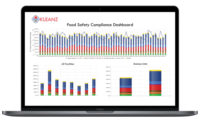Technology and automation to improve employee safety and reduce injuries

Technology and automation are essential in the food safety industry. Often, employees are doing repetitive tasks which can increase the chance of injury, and these are tasks that sometimes can be assigned to robots or other technology instead.
Improving plant staff safety
“The top goal of safety for food processing and packaging operations is to protect people in the plant, followed by ensuring product safety to protect consumers,” says Mark Ruberg, packaging industry manager, Beckhoff Automation LLC, Savage, MN.
Achieving both begins with machine design best practices, including proper risk assessments and implementation of today’s functional safety technologies, he says.
“Risk assessments should meet industry recognized standards, such as ANSI B155.1-2016, which provides a formal method to identify risks on packaging machinery, eliminate or mitigate risks and, finally, document the process and results. They should also include general, international safety standards, such as EN 615080, IEC 62061 and ISO 13849, to define the SIL and PL levels according to how much harm the machinery could cause to workers,” Ruberg recommends.
Proper risk assessments look at the probability and severity of all potential hazards so [that] potential injury can be minimized by designing out problem areas, he notes.
“In production lines involving more than one machine, for example, a risk assessment needs to consider the ‘hands off’ zones that exist among the machines on the production line. The solution often includes a combination of policies and training, physical barriers and safety devices or controllers designed into the machine. All safety systems must provide built-in redundancy, ensuring that communication will not and cannot fail. When a worker hits an e-stop or steps through a light curtain, the safety system must stop potentially dangerous processes to protect workers,” Ruberg adds.
Integrated safety solutions, including TwinSAFE from Beckhoff, incorporate these capabilities directly in the standard machine control and networking environments.
These options are more reliable—that is, safer—than older, conventional e-stops and relays, Ruberg comments.
“Safety controllers from Beckhoff integrate directly into the TwinCAT automation software engineering and runtime, allowing easy programming with function blocks. This provides one platform with a more holistic approach to safe machine operations. As a result, TwinSAFE also supports more complex logic via software solutions. This not only simplifies the wiring of the safety systems, but it also allows for easier code reuse to speed up programming and commissioning of future systems.”
TwinSAFE uses TÜV-certified Safety over EtherCAT (FSoE) to accomplish this goal, sending safety data on the same robust EtherCAT industrial Ethernet network via a “black channel” approach with the necessary redundancies, he says.
“EtherCAT also interfaces with more than 25 additional networking standards, such as PROFIBUS, PROFINET, DeviceNet and EtherNet/IP. Since the I/O system is more modular and flexible than traditional methods, engineers can create safety zones on machines that allow maintenance personnel access to portions of the machine without shutdown of the entire machine. This increases uptime without creating unsafe conditions and leads to faster adjustments or expansions in the field.”
Diane Blair, director of international services, training and technical communications, Honeywell Intelligrated, Mason, OH, says that the evolving design of conveyor, palletizing and robotic technologies have progressed to a place that keeps the operator safety in mind.
“The technology has moved to include many design elements that provide safe interaction and responses for the operators. This includes the basics of enhanced guarding and eliminating sharp edges and pinch points to the deployment of 24-volt conveyors, robotic picking and transportation operations, shuttles and automated truck unloaders,” Blair says.
These technologies and enhanced designs not only eliminate typical crush or cut type limb injuries but also address the ergonomics of traditional applications to provide relief of stress injuries, she adds.
“Some technologies such as shuttle systems and robotic picking and transportation of product takes the operator safety by limiting the direct interface of employee to machine. This higher level of automation allows for customers to build their operations in such a manner that the majority of machine interface is limited to the maintenance personnel.”
Minimizing risk of injury
At Bischofszell Nahrungsmittel AG, a subsidiary of the Migros Group (Switzerland), the potential of new technologies is currently being explored. In a pioneering MRC (“Man-Robot Collaboration”) pilot project over a fixed period, the management set out to achieve two objectives, namely the efficient production of food and the humanization of the workplace, says Sebastien Schmitt, North American Robotics division manager, based off the North American headquarters of Stäubli Corporation in Duncan, South Carolina.
Steffen Knoll, technology project manager at Bischofszell Nahrungsmittel AG and dedicated automation expert, is a major advocate of the MRC (Man-Robot Collaboration) concept, and not merely for reasons of increased capacity, he says: “MRC offers a completely new range of possibilities. It obviously gives us the opportunity to expand our capacity relatively easily, but it also enables us to provide targeted support by means of robotics to the strengths of our employees in terms of flexibility and intelligence, thereby minimizing health hazards and the risk of injury to humans arising from stressful activities.”
While the distribution of the ready meals on the aluminum trays and the placing of spacers between the individual layers are among the more agreeable jobs on the packing line, stacking the large metal trays on the trolleys is by no means a popular activity, says Knoll. Manhandling the trays, which measure 900 by 900 millimeters and weigh in at a hefty five kilos, over a full eight-hour shift is heavy work. The trays have to be slotted accurately into the trolley, which brings with it the risk of crushed fingers.
“Our employees are very experienced in this work, but risk of injury cannot be ruled out,” adds Knoll. “What could be more appropriate than a division of the entire handling process between man and machine? Also, in direct collaboration at a single compact work station without being separated by a safety barrier, the more agreeable tasks can be assigned to the human employee and the strenuous operations involving risk of injury to the robot. It seemed to us that MRC presented an effective solution.”
“Collaborative robots is a trend that Staubli Robotics addressed very early with considerable efforts in R&D. The result is our new generation of 6-axis robots called TX2 who are SIL3-PLe rated and can be used either as full industrial robot (MRC1 with standard TX2) or in the highest collaboration configurations (MRC5 with TX2 TOUCH POWER Cobot) and every other level in between. This is possible thanks to hardware features such as safety brakes on the arm but even more so thanks to our new extremely powerful robot controller called CS9.” says Schmitt.
Another big part of making robots more “human-friendly” lies in the ease of programming.
“Robot manufacturers like ourselves must offer solutions to enable operators on the production floor to interact with the robot without having a programing background. There are many ways to address this topic and one of them is our uniVAL plc solution that enables to interact with the robot via the HMI. End users no longer need to learn or work with multiple integrated machine pendants, software and controllers with this solution. We work with the main PLC manufacturers to develop programing interfaces that are more user-friendly and Beckhoff, for instance, was one of them,” says Schmitt.
The collaboration and sharing of the workspace between man and machines is now taken to another level with the very latest of robotics development: Autonomous Mobile Robots (AMR’s) and Autonomous Guided Vehicles (AGV’s). “One of our new flagship solution is the HelMo, part of our expanding mobile robotic offering. It is one the most advanced, versatile and capable AGV on the market today.” declares Schmitt. Stäubli’s mobile robot system HelMo is an autonomously driving and navigating vehicle that has been developed especially for human-robot-collaboration.
Three integrated laser scanners are permanently monitoring the system`s surrounding and ensure precise navigation and safety. In combination with the new TX2 robot and the CS9 robot controller including features like safe speed, safe stop and safe zone/safe tool, a safe collaboration is guaranteed.
To work at different locations during its operation, the system is equipped with multi couplings, tool changing system and tool station. Thanks to its modular structure and robust drive technology, it can be used in almost every industrial sector like provisioning, logistics, assembly or quality control.
The power supply is designed to support an 8-hour work shift (an indication that can vary upon usage). Even more, the system can charges during its work by connecting itself to a docking station. (source: Stäubli HelMo PDF)
Best practices for improving product safety and quality
Process management is influenced both by the way that automated system drives the operator and by the way that the customer builds the overall operational processes in the individual buildings, says Blair.
“The use of some of the more automated technologies that keeps the operator at a further distance from the machines is the best method to increase safety within the facility, [plus] performing subsystem and overall system risk assessments. Additionally, the performance of job safety analysis will help to identify potential injuries in the performance of each job in the facility. This data is used to make safety modifications and upgrades to existing operations and ultimately used to make design changes and identify potential hazards in products moving forward,” she says.
By incorporating more safety devices in more places, food processing and packaging operations can increase safety for people, equipment and products, says Ruberg.
“Today’s integrated safety systems come in many form factors, from IP20 I/O modules installed in a control cabinet alongside the PC-based machine controllers up to field-mounted devices. A number of IP67-rated I/O blocks can directly integrate safety via FSoE and connect with sensors, motors and drives, as well as other components in the field. This allows many devices to play dual roles in production and functional safety. Easy manipulation of safety devices, which are automatically addressed via TwinCAT and EtherCAT, permits customization and modular modifications in the field,” he notes.
Compared to traditional, hard-wired e-stops, integrated safety devices can also provide more contemporary monitoring and control options, Ruberg adds.
“For example, analog safety can be used to monitor safe speeds or temperatures, within a set range, and safely shut down the machine if it violates that range. As a result of the constant monitoring, production reliability increases along with product quality, leading to fewer rejects and more consistency with recipes,” he comments.
Smarter components and safety controllers in a PC-based automation platform deliver better diagnostics for faster troubleshooting, Ruberg says.
“Error messages and alerts can be relayed in plain text to plant HMIs, push notifications for smartphones, Andon boards or a central maintenance computer. In addition, data about machine performance and safety events can offer key insights for improving machine performance, identifying why devices are triggered and scheduling maintenance to prevent potential incidents.”
The inherent connectivity and data-logging capabilities of PC-based control provide for better track and trace in production, recommends Ruberg.
“Industrial PCs (IPCs) and embedded machine controllers from Beckhoff can provide standard PLC functionality while also offering various data libraries, analytics, machine learning, edge computing and IoT solutions on-board. This allows engineers to start on the best footing for safety when they begin designing a machine—which is really when they need to think hard about safety,” Ruberg notes.
Implementing safety, from the device level to plant policy, should not need to be done in the aftermath of a tragedy, he says.
“The well-being of employees and consumers should be included in the design process right from the beginning.”
Looking for a reprint of this article?
From high-res PDFs to custom plaques, order your copy today!






